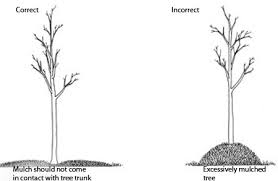
Certain jobs are more appropriate for winter tree work, depending on access to the yard and the work being done. In some cases, we may ask clients to help us clear a path to the tree, if there has been a large snowfall.
Here are a few types of tree work that are ideal for winter:
- Removals: When the ground is frozen, there is less impact on lawns and gardens surrounding the tree being removed.
- Forest work: Such as plantation thinning and trail clearing.
- Pruning: Most trees can benefit from pruning done during the dormant season. Dormant pruning helps the tree focus its energy effectively come spring.
Even if you’re not considering pruning or removals in the winter, it is very important to consider the impact of the winter on your trees and think about how to protect them!
In this blog, we’ll be going over some common tree protection techniques for the winter and explain how winter tree damage can occur.
Tree Protection for Winter
Before the winter starts, there are a number of techniques you can use to protect your trees from harsh weather and the elements:

1. Mulching
Newly-planted trees should be mulched around their root zone to help hold in moisture and protect the roots from the freeze-thaw cycle that can happen in late fall or early spring. This mulch can also act as a buffer for road salt, protecting the tree from salt damage.
When mulching, remember that it is important to avoid piling mulch around the trunk, as this can be harmful to the tree.
2. Staking
Recently planted trees in windy, exposed areas may also benefit from being staked for the winter, so they are not blown down. Stakes can be removed in the spring, so the tree can get used to the wind in its new home.
We suggest using wooden stakes, instead of metal bars, and arbortie (a flat, woven material) instead of wire. Wire can girdle the tree and metal bars left in place may be difficult to remove, if the tree grows around it. We have removed many old trees with metal from stakes and fences inside them.
3. Tree Guards
Adding a tree guard is a good choice for new trees that have young bark and are more susceptible to sunscald or frost damage. Tree guards can also protect trees from hungry rodents chewing (browsing) at the bark.
Sunscald is especially common in Sugar Maples but can occur on other species as well. Sunscald effects the southwest side of the tree. The warm, late winter sun beats down on the trunk and the sap begins to flow. At night, when the temperature drops, the tree freezes up and the young bark splits. Over time, this causes large calluses to form.
4. Burlap Wrapping
Some evergreen trees will benefit from being wrapped in burlap to prevent the weight of snow pushing down on their branches. Burlap also helps prevent salt damage and wind burn for these trees.
5. Winter Pruning
Mature trees that are overgrown or that have been previously damaged in storms may require some pruning to protect the tree from failure during harsh winter weather. During the winter months, when the trees have no leaves, it is easier to see the structure of the tree to prune it appropriately and effectively.
Winter Tree Damage

Winter tree damage can come in many forms, but ice and salt are two of the main culprits! Find out how to avoid this type of damage to your trees this winter with tips from our team.
Ice Damage
We have all seen the devastation that one ice storm can do to our trees. The heavy weight of ice built up on branches can cause them to fail. Trees that have had damage in the past may be more prone to future damage.
To avoid this, proper pruning of storm damaged trees is necessary. The sooner you address a damaged tree, the better — especially if there are branches left with cracks and fractures that have not yet failed.
It is important to have a trained arborist evaluate your tree if storm damage occurs. Preventative maintenance can lower the chances of failure during severe weather. It’s never too early to start taking care of your trees!
Salt damage
Salt spray from the road can damage trees in many ways. In evergreens, it can make needles dry out and turn brown. Deciduous trees may have the terminal buds die, causing the new growth to be densely clustered together. This is called witches’ broom and can be caused by various pathogens as well as salt damage.
Salt in the soil also makes it harder for roots to take in water effectively. When the salt (sodium chloride) breaks down into its elemental form, each element can be taken up into the tree causing nutrient deficiencies and poor growth. Some trees are more salt tolerant than others, including Red and White Oak, Blue Spruce, and Austrian Pine.
Squirrels
One common injury to trees is caused by squirrels foraging in the winter months when there is less food available. They nibble on the bark to get at the sap underneath for a sweet snack to hold them over until Spring. This type of wound creates a canker over time leading to decay and increased risk of branch failure.
If you’re looking to protect your tree from winter damage, contact the team at Baum Tree Care for help with expert pruning, tree protection, and more!


You must be logged in to post a comment.